A small tree in a small pot needs to be looked after. When and how are outlined in the next few pages and in the work schedule. The aim of growing bonsai is not miniaturisation alone, but the end product of cultivating a healthy and well proportioned tree using appropriate training techniques. Healthy but controlled growth is required. To be healthy the tree needs adequate feeding and sufficient air and water; thus the bonsai is not deprived for the purpose of dwarf-ing. Nor is there any chemical dwarfing agent applied to bonsai. It is well to remember that
when a plant stops growing it begins dying and some bonsai alive today are recorded as being
over 400 years old.
Any person who wishes to grow bonsai should spare at least ten to 20 minutes every day to the task. Without such effort successful bonsai grow-ing can hardly be expected. However even a city f l at dweller with no previous experience of gardening can grow bonsai successfully provided there is a convenient window box or balcony for the trees to live on. Most bonsai are hardy and must live out of doors. They should rarely be brought indoors for more than 24 hours at a time.
In contrast to the non-gardening flat dweller, those who are accustomed to growing plants will find that the techniques of growing bonsai are largely based on good garden practice.
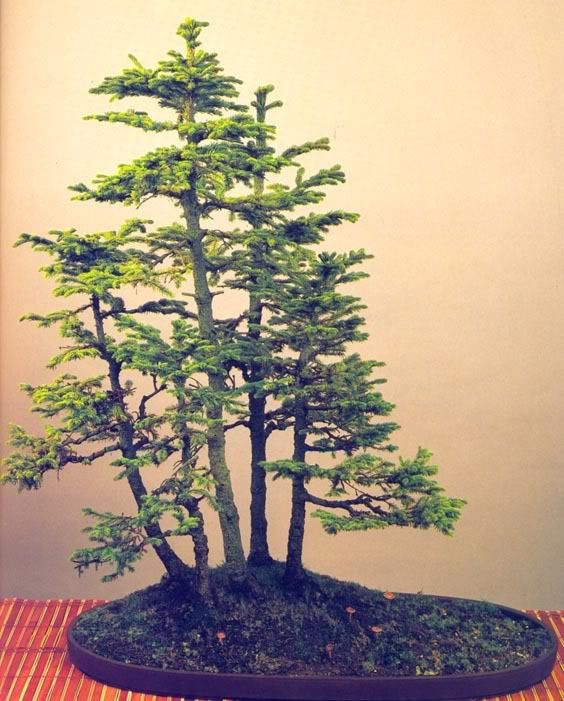
GROUP STYLE SPRUCE
(Picea glehnii)
The tallest tree in this group is 36 inches and is about 40 years old. Originally imported in the early 60s, it has undergone inevitable changes but has always retained its charm. The tiny fungi growing in the pot are natural, and their presence is an indication that the trees are in good health. They help to break down the nutrients in the soil, making these easier for the tree to absorb.
In general a bonsai will take longer to come to maturity than it would if grown in open ground. If well cared for and protected it may well out-live an ordinary tree. Not all trees are equally slow in growing, and trees which begin as cut-tings or layerings - or, faster yet, as small and untrained promising nursery trees from a garden centre - have a good start over trees grown from seed. In certain circumstances trees grown in open ground may provide an even better start. A very acceptable bonsai can be created in about three years and give a great deal of enjoyment in that time as well as much subsequent satisfac-tion. The chief beauty of the bonsai is the impres-sion of maturity which can be created in a rela-tively young plant given the right species, speci-men and skills. Even from seed a very pleasing larch or maple bonsai can be produced in a few years.
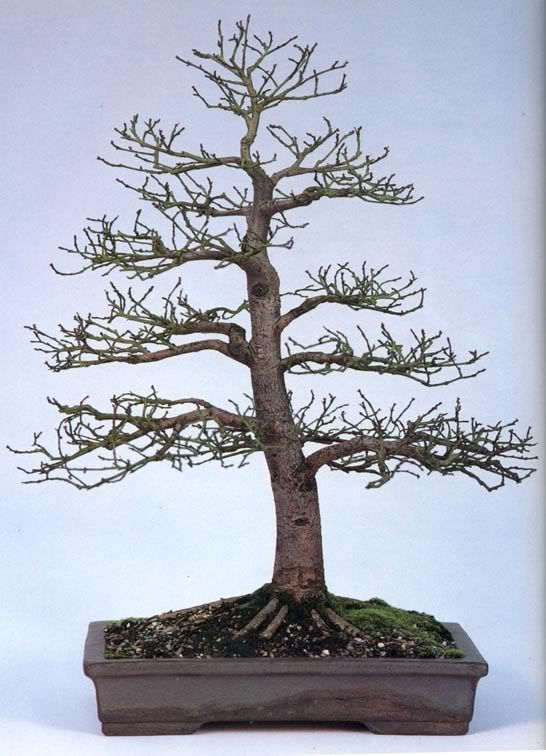
INFORMAL UPRIGHT STYLE WMEATLRY ELM
(Ulmus carpinifolia wheatleyi)
At only eleven years old this tree conveys the feeling of maturity with its strong trunk line and well-positioned branches. It was developed from a self-sown seedling and now stands at 12 inches tall.
POTTING,
REPOTTING AND ROOT PRUNING
Bonsai exist only in containers; it is a combina-tion of growing in the container and training that makes the bonsai. A healthy bonsai puts out new roots every year and these make it increasingly difficult for water and air to penetrate the soil. The plant will therefore become pot bound and regeneration of the roots will slow down and eventually stop unless the roots are cut back from time to time. How often this is done depends on the tree's rate of growth. Evergreens
may only require root pruning once every three or four years; some deciduous trees once every two or three years; very quick growing trees every year. The best season for repotting is in
early spring up to the time when the first buds break.
Certain flowering trees, e.g. quince, are an exception and should be repotted immediately after flowering, but in general the idea is to root prune at a time when new root growth will be rapid and also when the tree has not made any new top growth. If root pruning when the tree is
in full growth is unavoidable, it may be necessary to trim the top also.
The usual method of root pruning is to remove the tree from its pot and inspect the root ball. If it appears necessary to root prune then about one third of the soil is teased out from the sides and underside of the root ball to leave the exposed roots hanging freely; these are cut off carefully
with scissors. The tree is then replanted in the same pot with fresh soil, tied into the pot if necessary to secure it, kept in shade and given extra attention until regeneration of the roots is well advanced.
The mineral particles that make up natural soils range from sand, the coarsest, to clay, the finest. Clay will retain water and sand will pro-vide good drainage. The roots of plants require
both air and water and a good soil has a high percentage of air-water space in relation to its
solid elements. An ideal soil in addition to having the structural porosity of sand and the
water-retaining ability of clay, contains the right amount of decaying vegetable and other organic matter which we call humus. Such a soil will suit most bonsai, although too much clay will tend to compact the compost and clog the air spaces. The enthusiast can either make up his own or use as a base a proprietory compost. The Japanese sieve their potting soils, retaining several granular sizes but discarding very fine particles. They pot with dry soil. Dry soil can be tamped around the roots without destroying its granular structure but damp potting soil containing clay will lose much of its porosity if firmly packed into the pot.
 FORMAL UPRIGHT JAPANESE
FORMAL UPRIGHT JAPANESELARCH
(Larix leptolepis)
In 1977 a spindly six year old seedling was rescued from a bonfire. It had a severe
right-angle bend in the trunk and no useful branch structure. Nevertheless, eleven
years of patient training and ingenuity have miraculously produced this 18 inch high formal upright.
When potting or repotting, the drainage hole or holes in the pot are covered with a porous material, such as plastic mesh, and a thin layer of coarse soil particles is spread over the base of the pot to ensure good drainage. Finer soil is worked into the roots until potting is satisfactorily completed. The top can then be dressed. Finally, the planting is thoroughly but gently watered. At a later stage moss or rocks may be added.

The roots of a bonsai may be examined by carefully easing the tree out of its pot. If it appears to be root-bound it is ready forrepotting.

Using a chopstick, knitting needle or similar, carefully tease out the roots. Work from the top downwards, and from the centre outwards. Take special care not to damage any of the major roots close to the trunk.

Using sharp scissors cut away up to a third of the excess roots, especially the thicker ones. Stop when you have removed enough of the root mass to enable the tree to be replaced in its pot with space all around for fresh compost.
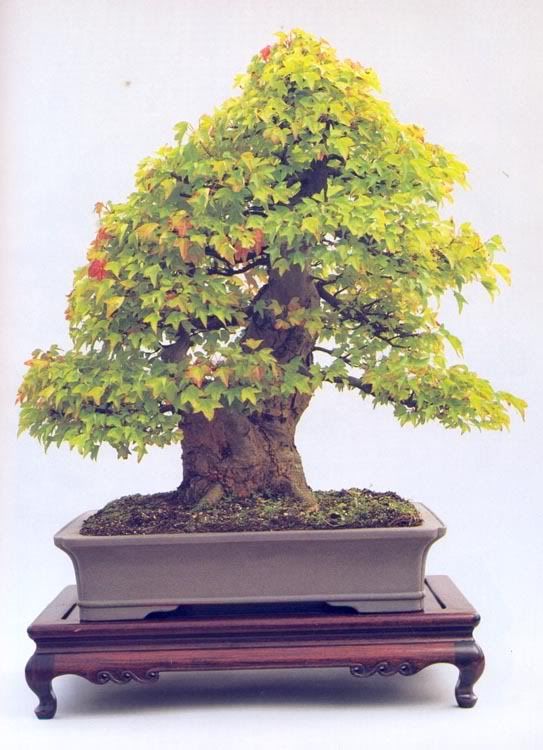
TWIN TRUNK STYLE TRIDENT MAPLE
(Acer buergerianum)
The immense eight inch thick trunk base and exaggerated taper give this 24 inch tall tree a masculine appearance. It took only 60 years to achieve this dramatic effect, which is why trident maples are so popular as material for bonsai.

INFORMAL STYLE POTENTILLA
(Potentilla fruticosa)
Originally a garden shrub, this striking 30 inch tall tree was styled in 1983, 16 years after it was first lifted and planted in a container. The open structure and extended flowering season combine with the flaking bark to create an aged yet elegant bonsai.
POTS
The pot of a bonsai is like the frame of a picture and it should be selected carefully to show the plant or plants to the best advantage. The pot must have adequate drainage and be made of a material which looks well and will withstand exposure to frost and weathering.

To create a visual balance the length of the pot should be two-thirds to three-quarters of the height of the tree.

If the tree is low and spreading the pot should ideally be about three-quarters of the width of the tree. Avoid using a pot whichhas similar dimensions to either the height or the width of the bonsai.
The depth of the pot should
roughly match the thickness of the trunk, although with very thin trees or cascades this will not always be possible.
The width of the pot, from front to back, should be a little less than the tree.
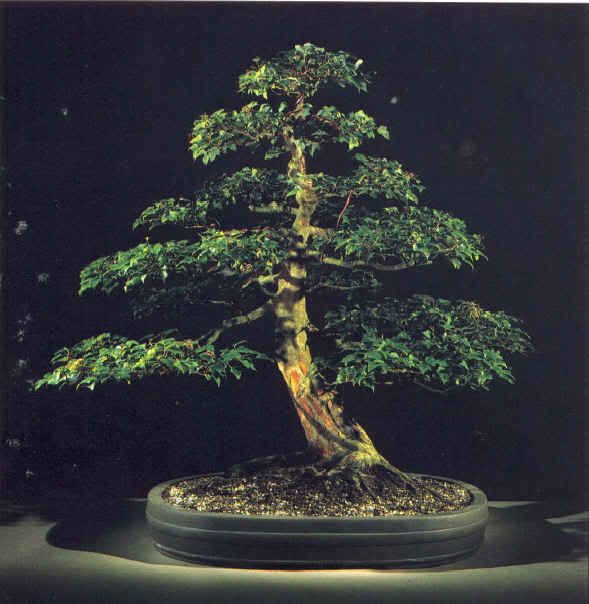
INFORMAL UPRIGHT TRIDENT
MAPLE
(Acer buergerianum)
This tree was imported as a stump in 1976. All the branches and twigs have been
grown from scratch since then. The well-
formed root flare and gnarled trunk give this 40 year old tree an air of great maturity.
Shallow flower pots or seed trays make good training pots. When the training of a bonsai is sufficiently advanced, a pot is chosen in which to display it, the size and shape depending upon the size and shape of the tree. Upright trees show to advantage in oval or rectangular pots and are placed slightly off-centre. In a round or hexagonal pot the tree is best placed centrally. Heavy,deep pots suit a thick trunk and thick dark foliage whereas a tall and lightly framed tree
requires a shallow and more delicate pot to show it to advantage.Imported Japanese pots are becoming more expensive but local potters are making pots suit-able for bonsai and the enthusiast can make his or her own, at least in the smaller sizes, at an evening class.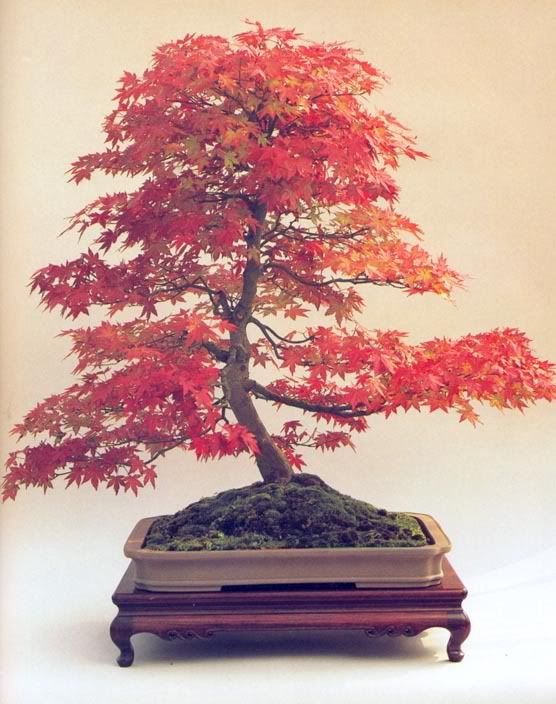
INFORMAL UPRIGHT JAPANESE
MAPLE
(Acer palmatum)
Japanese maples are valued for their striking autumn colours as well as their delicate foliage. This 22 year old specimen was a nondescript branchless trunk when it was imported in 1977. Since then
12 inches have been added to the height and all the branches have grown on to produce a very graceful bonsai.
Please look info to ..... Previous BONSAI TREES......next TRAINING AND MAINTENANCE






No comments:
Post a Comment